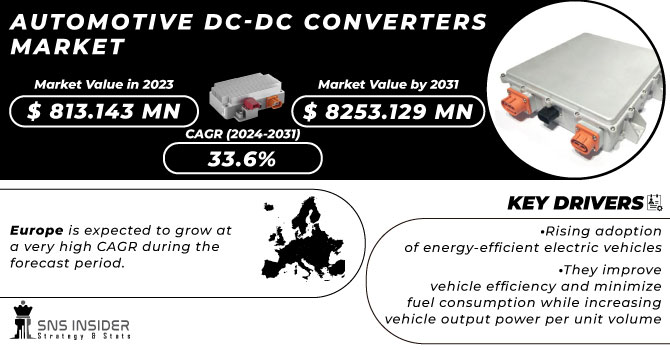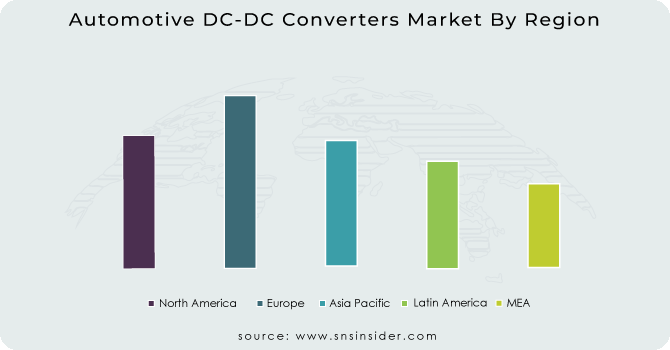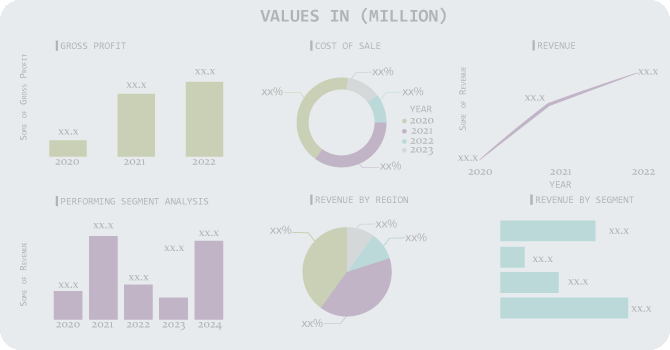The Automotive DC-DC Converters Market Size was valued at US$ 813.143 million in 2023 expected to reach USD 8253.129 million by 2031 and grow at a CAGR of 33.6% over the forecast period 2024-2031.
The demand for electronic systems such as entertainment and increased safety through the integration of ADAS in modern automobiles is driving market expansion. The growing popularity of electric vehicles, both battery-powered and hybrid, has increased demand for DC-DC converters, as a DC-DC converter is required to convert a 24V or 48V power supply into a 12V power supply in order to assure the safe and dependable operation of onboard electrical equipment. Factors such as variations in global car manufacturing may impede market growth, resulting in an oversupply situation that could harm market participants' financial positions.

Get More Information on Automotive DC-DC Converters Market - Request Free Sample Report
KEY DRIVERS:
Rising adoption of energy-efficient electric vehicles
They improve vehicle efficiency and minimize fuel consumption while increasing vehicle output power per unit volume
RESTRAINTS:
Regulatory compliance and safety standards vary by region or country
These requirements and standards must be followed by DC-DC converter manufacturers
OPPORTUNITIES:
Miniaturized DC-DC converter development to achieve high-efficiency and high-speed
Miniaturized DC-DC converters have reduced output noise and can operate at higher temperatures
CHALLENGES:
Low-quality goods on the black market
The COVID-19 epidemic has had a profound impact on the global automotive industry. Symptoms include disruptions in the export of Chinese parts, disruptions of major products throughout Europe, and closures of mergers in the US. This puts a lot of pressure on the industry which is already facing a declining national demand and which could lead to an increase in merger and acquisition activity. According to industry experts, car sales are likely to fall by 14-22% between Chinese, US, and European markets by 2020. The automotive industry in the US continued to weaken in August and September, while China's car sales. they can continue their recovery as soon as possible. Vehicle exports reached about 2.4 million units in August, an increase of 11.8% according to reports. The simplification of land closures in many European countries coupled with economic recovery packages seems to have begun to benefit the region's automotive industry. The COVID-19 epidemic has led to many changes in the behavior and behavior of car buyers. Digital services and features are easily accepted by people as a way to stay connected, track able, and secure. Increased penetration of car screens will lead to easier integration of many of these digital features. Therefore, the rise of digital technology practices in automobiles, communications, and improved safety features will drive the need for DC-DC converters.
The automotive DC-DC converters market is divided into two segments: commercial vehicles and passenger vehicles. During the forecast period, the passenger car category accounted for the biggest proportion of the automotive DC-DC converters market. Tesla, Honda, Hyundai, and Ford, among others, are producing passenger electric vehicles in order to reduce GHG emissions from the automobile sector. Furthermore, government programmer such as tax breaks for electric car use are raising consumer demand for environmentally friendly automobiles for private and shared mobility, which is driving demand for passenger vehicles. Based on the type of propulsion, the DC-DC automotive conversion market is divided into battery-powered vehicles, fuel cell electric vehicles, and plug-in electric vehicles. The BEV component is estimated to have the largest share and grow at the highest CAGR at the time of forecasting. This is due to the increasing demand for electricity in the automotive sector. In addition, increased environmental awareness, government subsidies, and tax exemptions are expected to lead to an increase in the demand for DC-DC converters in this sector. Industry experts say that, worldwide, countries are converting petrol and diesel cars into electric vehicles. Due to the rapid transition to EVs, some estimates suggest that by 2028, EVs will account for more than 50% of new car sales worldwide. Moreover, in line with the transition to EVs, the development of autonomous vehicles is accelerated. To meet the growing demand for BEVs, a variety of players are developing advanced, integrated DC-DC converters.
The demand for electronic systems such as entertainment and increased safety through the integration of ADAS in modern automobiles is driving market expansion. The growing popularity of electric vehicles, both battery-powered and hybrid, has increased demand for DC-DC converters, as a DC-DC converter is required to convert a 24V or 48V power supply into a 12V power supply in order to assure the safe and dependable operation of onboard electrical equipment. Factors such as variations in global car manufacturing may impede market growth, resulting in an oversupply situation that could harm market participants' financial positions.
By Product Type
Isolated
Non-isolated
By Vehicle Type
Commercial Vehicle
Passenger Vehicle
By Output Voltage
3.3V
5V
12V
15V
24V and Above
By Propulsion Type
Battery Electric Vehicle
Fuel Cell Electric Vehicle
Plug-in Hybrid Vehicle
By Input Voltage
<40V
40–70V
>70V
Europe is expected to grow at a very high CAGR during the forecast period. The European market is projected to show growth in the coming years, due to increased demand for electric vehicles. It is home to major car manufacturers such as Volkswagen AG, BMW AG, and Daimler AG. According to Clean Technica, the European passenger car market witnessed 35,000 registrations in January 2022. In the first month of 2023, total electricity exceeded 69% Annually, with about 23,000 deliveries. This is now 63% of all imported vehicles, vehicles sold, resulting in a record 1.8% share of electric vehicles. In Europe, almost all vehicles are EPS enabled and start stopping systems. The increase in electrification of these components contributes to the significant demand for electrical and electronic components, including DC-DC converters.

Need any customization research on Automotive DC-DC Converters Market - Enquiry Now
REGIONAL COVERAGE:
North America
USA
Canada
Mexico
Europe
Germany
UK
France
Italy
Spain
The Netherlands
Rest of Europe
Asia-Pacific
Japan
south Korea
China
India
Australia
Rest of Asia-Pacific
The Middle East & Africa
Israel
UAE
South Africa
Rest of Middle East & Africa
Latin America
Brazil
Argentina
Rest of Latin America
The Major Players are Hyundai Mobis, Robert Bosch GmbH, BorgWarner Inc., Denso Corporation, TDK-Lambda Corporation, Delta Electronics, Continental AG, Toyota Industries Corporation, Valeo, Vicor Corporation, and other players.

| Report Attributes | Details |
|---|---|
| Market Size in 2023 | US$ 813.143 Million |
| Market Size by 2031 | US$ 8253.129 Million |
| CAGR | CAGR of 33.6% From 2023 to 2030 |
| Base Year | 2023 |
| Forecast Period | 2024-2031 |
| Historical Data | 2020-2021 |
| Report Scope & Coverage | Market Size, Segments Analysis, Competitive Landscape, Regional Analysis, DROC & SWOT Analysis, Forecast Outlook |
| Key Segments | • By Vehicle Type (Commercial, Passenger) • By Propulsion Type (BEV, FCEV, PHEV) • By Product Type (Isolated, Non-Isolated) • By Output Voltage (3.3V, 5V, 12V, 15V, 24V and Above) • By Input Voltage (<40V>70V) |
| Regional Analysis/Coverage | North America (USA, Canada, Mexico), Europe (Germany, UK, France, Italy, Spain, Netherlands, Rest of Europe), Asia-Pacific (Japan, South Korea, China, India, Australia, Rest of Asia-Pacific), The Middle East & Africa (Israel, UAE, South Africa, Rest of Middle East & Africa), Latin America (Brazil, Argentina, Rest of Latin America) |
| Company Profiles | Hyundai Mobis, Robert Bosch GmbH, BorgWarner Inc., Denso Corporation, TDK-Lambda Corporation, Delta Electronics, Continental AG, Toyota Industries Corporation, Valeo, Vicor Corporation, and other players. |
| DRIVERS | • Rising adoption of energy-efficient electric vehicles • They improve vehicle efficiency and minimize fuel consumption while increasing vehicle output power per unit volume. |
| RESTRAINTS | • Regulatory compliance and safety standards vary by region or country. • These requirements and standards must be followed by DC-DC converter manufacturers. |
According to SNS insiders, the Automotive DC-DC Converters Market size was USD 608.64 million in 2022 and is expected to reach USD 3461.03 million by 2028 with a CAGR of 33.6% over the forecasted period.
These requirements and standards must be followed by DC-DC converter manufacturers and Regulatory compliance and safety standards vary by region or country.
Financial, Products/ Services Offered, SWOT Analysis, The SNS view.
Yes, you will get an free sample of this report for that you have to make an contact with our team.
Table of Contents
1. Introduction
1.1 Market Definition
1.2 Scope
1.3 Research Assumptions
2. Research Methodology
3. Market Dynamics
3.1 Drivers
3.2 Restraints
3.3 Opportunities
3.4 Challenges
4. Impact Analysis
4.1 COVID-19 Impact Analysis
4.2 Impact of Ukraine- Russia war
4.3 Impact of ongoing Recession
4.3.1 Introduction
4.3.2 Impact on major economies
4.3.2.1 US
4.3.2.2 Canada
4.3.2.3 Germany
4.3.2.4 France
4.3.2.5 United Kingdom
4.3.2.6 China
4.3.2.7 Japan
4.3.2.8 South Korea
4.3.2.9 Rest of the World
5. Value Chain Analysis
6. Porter’s 5 forces model
7. PEST Analysis
8.Automotive DC-DC Converters Market, By Product Type
8.1 Isolated
8.2 Non-isolated
9.Automotive DC-DC Converters Market, By Vehicle Type
9.1 Commercial Vehicle
9.2 Passenger Vehicle
10.Automotive DC-DC Converters Market, By Output Voltage
10.1 3.3V
10.2 5V
10.3 12V
10.4 15V
10.5 24V and Above
11.Automotive DC-DC Converters Market, By Propulsion Type
11.1 Battery Electric Vehicle
11.2 Fuel Cell Electric Vehicle
11.3 Plug-in Hybrid Vehicle
12.Automotive DC-DC Converters Market, By Input Voltage
12.1 <40V
12.2 40–70V
12.3 >70V
13. Regional Analysis
13.1 Introduction
13.2 North America
13.2.1 USA
13.2.2 Canada
13.2.3 Mexico
13.3 Europe
13.3.1 Germany
13.3.2 UK
13.3.3 France
13.3.4 Italy
13.3.5 Spain
13.3.6 The Netherlands
13.3.7 Rest of Europe
13.4 Asia-Pacific
13.4.1 Japan
13.4.2 South Korea
13.4.3 China
13.4.4 India
13.4.5 Australia
13.4.6 Rest of Asia-Pacific
13.5 The Middle East & Africa
13.5.1 Israel
13.5.2 UAE
13.5.3 South Africa
13.5.4 Rest
13.6 Latin America
13.6.1 Brazil
13.6.2 Argentina
13.6.3 Rest of Latin America
14. Company Profiles
14.1 Hyundai Mobis
14.1.1 Financial
14.1.2 Products/ Services Offered
14.1.3 SWOT Analysis
14.1.4 The SNS view
14.2 Robert Bosch GmbH
14.3 BorgWarner Inc.
14.4 Denso Corporation
14.5 TDK-Lambda Corporation
14.6 Delta Electronics
14.7 Continental AG
14.8 Toyota Industries Corporation
14.9 Valeo
14.10 Vicor Corporation
15. Competitive Landscape
15.1 Competitive Benchmarking
15.2 Market Share Analysis
15.3 Recent Developments
16. Conclusion
An accurate research report requires proper strategizing as well as implementation. There are multiple factors involved in the completion of good and accurate research report and selecting the best methodology to compete the research is the toughest part. Since the research reports we provide play a crucial role in any company’s decision-making process, therefore we at SNS Insider always believe that we should choose the best method which gives us results closer to reality. This allows us to reach at a stage wherein we can provide our clients best and accurate investment to output ratio.
Each report that we prepare takes a timeframe of 350-400 business hours for production. Starting from the selection of titles through a couple of in-depth brain storming session to the final QC process before uploading our titles on our website we dedicate around 350 working hours. The titles are selected based on their current market cap and the foreseen CAGR and growth.
The 5 steps process:
Step 1: Secondary Research:
Secondary Research or Desk Research is as the name suggests is a research process wherein, we collect data through the readily available information. In this process we use various paid and unpaid databases which our team has access to and gather data through the same. This includes examining of listed companies’ annual reports, Journals, SEC filling etc. Apart from this our team has access to various associations across the globe across different industries. Lastly, we have exchange relationships with various university as well as individual libraries.

Step 2: Primary Research
When we talk about primary research, it is a type of study in which the researchers collect relevant data samples directly, rather than relying on previously collected data. This type of research is focused on gaining content specific facts that can be sued to solve specific problems. Since the collected data is fresh and first hand therefore it makes the study more accurate and genuine.
We at SNS Insider have divided Primary Research into 2 parts.
Part 1 wherein we interview the KOLs of major players as well as the upcoming ones across various geographic regions. This allows us to have their view over the market scenario and acts as an important tool to come closer to the accurate market numbers. As many as 45 paid and unpaid primary interviews are taken from both the demand and supply side of the industry to make sure we land at an accurate judgement and analysis of the market.
This step involves the triangulation of data wherein our team analyses the interview transcripts, online survey responses and observation of on filed participants. The below mentioned chart should give a better understanding of the part 1 of the primary interview.

Part 2: In this part of primary research the data collected via secondary research and the part 1 of the primary research is validated with the interviews from individual consultants and subject matter experts.
Consultants are those set of people who have at least 12 years of experience and expertise within the industry whereas Subject Matter Experts are those with at least 15 years of experience behind their back within the same space. The data with the help of two main processes i.e., FGDs (Focused Group Discussions) and IDs (Individual Discussions). This gives us a 3rd party nonbiased primary view of the market scenario making it a more dependable one while collation of the data pointers.
Step 3: Data Bank Validation
Once all the information is collected via primary and secondary sources, we run that information for data validation. At our intelligence centre our research heads track a lot of information related to the market which includes the quarterly reports, the daily stock prices, and other relevant information. Our data bank server gets updated every fortnight and that is how the information which we collected using our primary and secondary information is revalidated in real time.

Step 4: QA/QC Process
After all the data collection and validation our team does a final level of quality check and quality assurance to get rid of any unwanted or undesired mistakes. This might include but not limited to getting rid of the any typos, duplication of numbers or missing of any important information. The people involved in this process include technical content writers, research heads and graphics people. Once this process is completed the title gets uploader on our platform for our clients to read it.
Step 5: Final QC/QA Process:
This is the last process and comes when the client has ordered the study. In this process a final QA/QC is done before the study is emailed to the client. Since we believe in giving our clients a good experience of our research studies, therefore, to make sure that we do not lack at our end in any way humanly possible we do a final round of quality check and then dispatch the study to the client.
The Bike Sharing Market Size was valued at USD 7 billion in 2023 and is expected to reach USD 18.64 billion by 2032 and grow at a CAGR of 11.5% by 2024-2032.
The Freight Forwarding Market was USD 205.21 billion in 2023 and is expected to reach USD 306.53 billion by 2032, growing at a CAGR of 4.59% by 2024-2032.
The Automotive Pressure Plates Market Size was valued at USD 27.60 billion in 2023 and is expected to reach USD 38.33 billion by 2031 and grow at a CAGR of 4.1% over the forecast period 2024-2031.
The Off-highway Vehicle Lighting Market Size was valued at USD 1.18 billion in 2023 & will reach $2.22 billion by 2032 & grow at a CAGR of 7.3% by 2024-2032
The Automotive Camshaft Market Size was valued at USD 5.75 Billion in 2023 and is expected to reach USD 8.24 Billion by 2032 and grow at a CAGR of 4.10% over the forecast period 2024-2032.
The Automotive Shielding Market Size was valued at USD 22.95 billion in 2023 and is expected to reach USD 33.52 billion by 2032 and grow at a CAGR of 4.3% over the forecast period 2024-2032.
Hi! Click one of our member below to chat on Phone